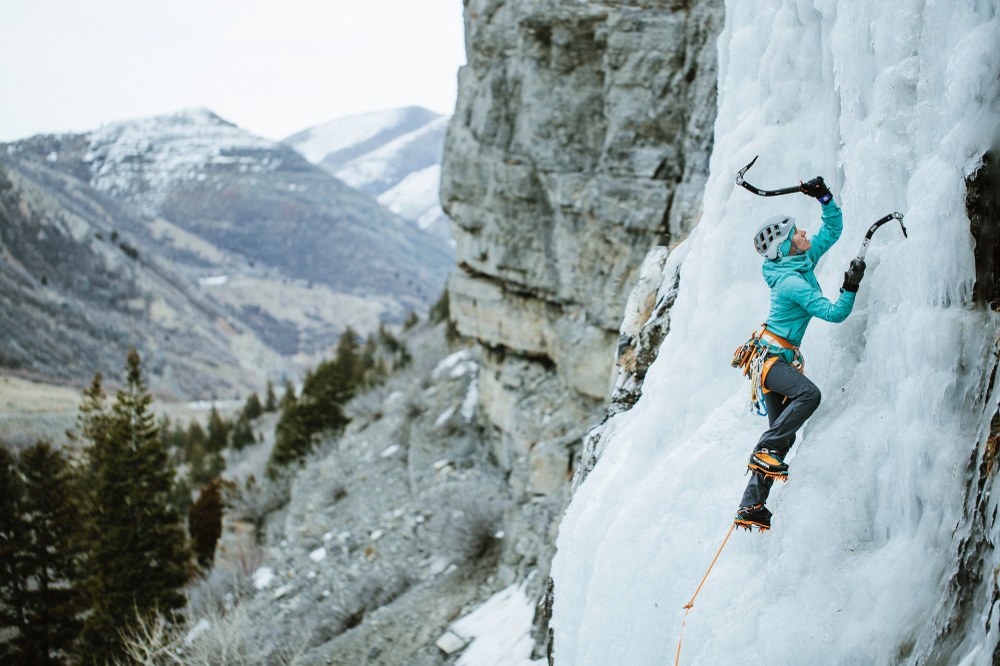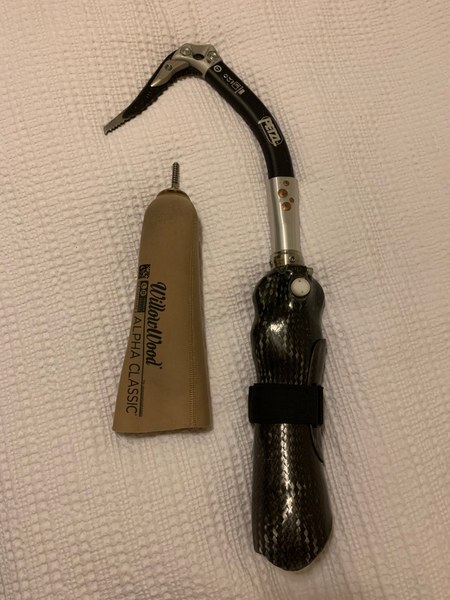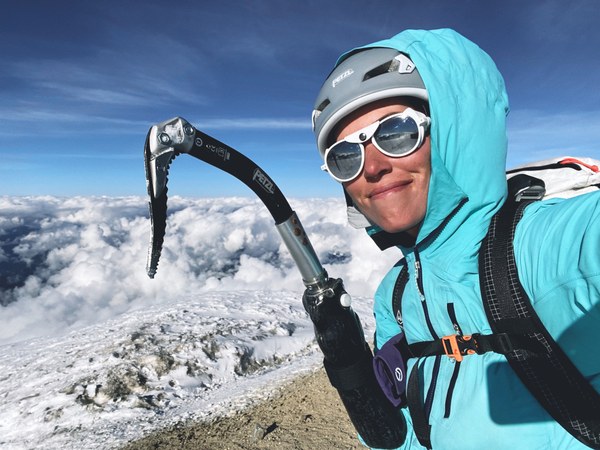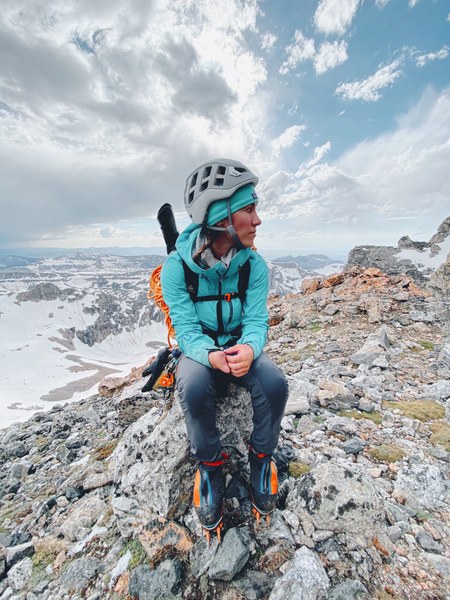
It’s a chilly March morning in Provo, Utah, 2020. Kimber Cross has been flown here by the outdoor meal brand Peak Refuel to shoot a short film about her journey into ice climbing. As the team walks down the snow-packed trail to a frozen waterfall, Kimber feels the eyes of passersby, and they’re staring. Maybe it’s because of the big, red cameras that stand in contrast to the stark landscape, but an old fear starts to creep into her psyche, a fear that tells her to hide. All eyes focus on the tool strapped to her pack.
In the outdoor industry, excess gear is often a catalyst for mockery. Extra equipment of any kind is unnecessary and could contribute to the team not fulfilling their mission. Most athletes adhere to the adage that lighter is better. And the tool attached to Kimber’s pack is not only bulky - weighing in at 2.7 pounds - but exposes her vulnerabilities.
Different?
Kimber has a limb difference - instead of a right hand, she has no fingers and a partial palm on her wrist. She was born this way, and when Kimber was a child, she didn’t see herself as different. Slowly, moments began to reveal her future and the way that society would look at her. One summer day at a McDonald’s playground, in brightly colored plastic tubes, Kimber caught the eye of a boy. Excited, her first response was to wave at him, and she instinctively raised her right hand. The boy, who had just moments before been so smitten, changed. His face aghast, he turned and ran away from her. At first Kimber didn’t understand. Then, her eyes rose to her arm still suspended in the air. There it was, in full view; what made her different, the reason he ran.
After that day she took more notice of small interactions like these, but didn’t really see herself as different until junior high, where she had to adapt in order to play sports. Kimber found herself daydreaming that her hand would grow back, like a frog when it loses a limb. She questioned her difference: was it a superpower or was it a curse?
Her parents gave her a book about Jim Abbott, a pitcher for the California Angels baseball team. He had one hand as well, and he was the first person that Kimber ever saw who was like her. He was the only representation in popular culture of someone with a limb difference. She used his inspiration to adapt and learn to play fast pitch and rugby, but with such little representation, she now understood how different she really was.
So encompassing was this new understanding of her difference that she started to hide. Camouflaging her arm became a regular habit. “You can’t find a picture of me from junior high to my late 20s where I’m not hiding my hand,” Kimber said. Pockets became a vital piece of her clothing, mandatory for any outfit, including formal gowns and other articles that typically didn’t have them.
Kimber went to great lengths to make sure she had pockets and would always have her right hand in one when out in public. A walk down the street or through a grocery store, a picture with her friends, or meeting new people, all had the same physical posture: Kimber with her hand hidden. She got so good at it that in high school when she started dating a fellow student, he called her after their fourth date and said, “My sister says you don’t have a right hand. Is that true?”
This habit carried her through the tumultuous years of high school and early adulthood, but it haunted her as a negative and unfair experience in society. She hid her difference because she feared the judgment of people, and this judgment was reinforced in unspoken ways every time she revealed her true self to the public. “Why are we so quick to not like the unfamiliar?” she said.
Adaptive athlete
In early 2017, Kimber signed up for the Basic Climbing course with the Tacoma Mountaineers. She wasn’t sure what to expect, but she knew that she wasn’t going to be able to hide her limb difference. From day one she had to keep up with the rest of the students and learn how to accomplish the skills in different ways. She persevered and embraced the new title of “adaptive athlete.” Dedicated to her climbing goals, she successfully graduated from Basic and moved on the following year to Intermediate; she has since become a Climb Leader.
By July 2020, Kimber challenged herself to a goal that she never could have imagined in her youth: the Kautz Route of Mt. Rainier. By this point she’d climbed waterfall ice in Hyalite Canyon, Montana; Ouray, Colorado; and Provo, Utah. But a Grade II ice climb to the summit of Washington’s highest volcano is a much greater challenge. With two long pitches between 40 and 50-degree slopes, the climb requires a high level of expertise.
For this trip, she carries the same tool she had on her pack with the film crew in Provo: a prosthetic that she could not ice climb without. When her climbing group gets to the base of the first ice pitch, Kimber feels a wave of anxiety. In order to accomplish today’s goal, she must not only face the adrenaline-soaked challenge of climbing a wall of frozen water, but she must also overcome decades of self-denial and insecurity to accept herself in a realm where, for the first time, she feels disabled.
She detaches the prosthetic from her pack and slowly begins affixing it to her right arm. It takes time to properly and safely secure the tool, and this time sets her apart from the rest of the crew. Silently, she wonders if the crew is judging her, if they’re frustrated that she requires additional time. But she breathes deeply and gives herself the grace and patience practiced as an instructor in The Mountaineers and in her career as a kindergarten teacher. These intentional breaths reinforce the knowledge that she has to take care of herself in order to teach, and in order to successfully accomplish today’s climb.

Kimber’s ice tool consists of a silicone-based liner with a locking screw and carbon fiber prosthetic sleeve. The Petzl Nomics is attached with a titanium connector, which can be angle-adjusted and detached to use different ice tools or prosthetic attachments. Photo by Kimber Cross
When her ice tool and all of her gear are in order, she walks around and makes sure everyone else’s gear is safe too. The team is ready, and they begin the climb.
Kimber doesn’t have the ability to execute the wrist flick that most climbers would use to swing a tool with a hand, so she uses the muscles in her shoulder. This requires more work. But because she uses her shoulder joint - and not a muscle or hand - she can relax into the tool. It’s a silver lining that Kimber’s right arm doesn’t get pumped; she’s able to hang on it when the tool is placed in the ice for long periods of time with no fatigue. There is no pain, although the silicone liner conducts the cold and gives her arm a chill.
Climbing the ice wall, Kimber feels completely connected. With extreme focus, she swings the prosthetic to get a secure placement. She cleans the route with her left hand, quickly removing the quickdraws from the ice screws her partner placed. She’s mastered these movements so that nothing is a hindrance while she climbs.

A self-portrait on the summit of Mount Baker after completing the North Ridge route, August 2020. Photo by Kimber Cross.
After completing the second pitch, the group navigates crevasses through the Upper Nisqually Glacier. Kimber has been on the summit of Mount Rainier a few times on Basic climbs, but today it feels much more profound. She’s led an intermediate ice climb of a volcano, overcoming her own limitations and moving into a world where she doesn’t have to live in the darkness of her past.
Able
Much has happened in her short climbing career. Not only is she a Climb Leader, but she’s a sponsored athlete with a short film coming out next year. Climbing and forming friendships with athletes on the North Face team, she participated in the first adaptive climber clinic at the Bozeman Ice Festival. While there, she was encouraged by Conrad Anker, who is actively supporting the work Kimber is doing in the community.
But perhaps more profound than any sponsor or event is the personal transformation. These days Kimber walks through the world without her hand in her pocket.
“I feel free,” Kimber says. “Mountain climbing was the catalyst for me to feel that freedom, of not feeling less than.” As an accomplished mountaineer, Kimber wants to empower everyone with the knowledge that the mountains have room for everyone. She hopes to share the freedom she has found, freedom that has broken the chains of her insecurity and allowed her to accept herself as an equal.
At work in her kindergarten classroom in Tacoma, Kimber sets books around the room purchased by her latest fundraising endeavor: selling tie-dyed sweatshirts to raise money for diversifying classroom libraries. When she looks back on her childhood, she sees an absence of people who looked like her in the world. If she had seen other people with limb differences doing amazing things, she wonders if her journey would have been a bit easier. Would the possibilities have seemed greater? “Representation is love,” she says, and her fundraiser was intended to share that love with people from all walks of life. With the support of strangers, the children of her school now have books that show diverse people like themselves doing amazing things.

Kimber happy to be alive after bailing off of Black Ice Couloir on the Grand Teton due to an intense thunder and lightning hail storm. Photo by Sam Sala.
Due to COVID-19 much of the school year will be conducted online, but in these first few weeks Kimber is meeting children and their families face-to-face to get to know each other and each student’s needs. Today’s family is a single mother and son who just moved here from the East Coast. After their introductions, the young boy reaches out and touches Kimber’s right hand. The black skin on his small hand wraps around the white stump on her right arm.
“What happened?” he asks.
“I was born this way,” Kimber says with ease. “It looks like a kitten’s face, don’t you think?”
The boy seems to be working it out in his head, so Kimber pulls out her phone to show him a picture of her climbing a wall of ice. His mother says, “You will not find me on a mountain top, but I’ve been climbing my own type of mountains recently.” Their conversation meanders between race, representation, inclusion, and love. They discuss the power of community to make a change. The power of our stories to shift the paradigm of what representation looks like and what is possible. Tears flow as the two women realize they have so much in common, even if their lives look different.
As they leave, the mother sees book covers with kids that look like her son, and thanks Kimber for bringing the community together through the fundraiser. “If I had representation growing up, I would have felt more capable,” Kimber said. “I want my students to see themselves at our read-alouds.”
They say their goodbyes feeling more like friends than strangers. The little boy waves goodbye. Without reservation, Kimber raises her right hand and waves back.
Kimber Cross is a Mountaineer, photographer, and adaptive athlete changing the narrative around ability in the outdoors. To keep up with Kimber’s adventures or reach out to her with questions, follow her on Instagram @kimberbelle. Lance Garland is a Mountaineer, author, and firefighter based in Seattle. In addition to two stories in Mountaineer, his writing has appeared in Outside, The Seattle Times, and The Stranger. Learn more at lancegarland.com.
This article originally appeared in our Winter 2021 issue of Mountaineer Magazine. To view the original article in magazine form and read more stories from our publication, visit our magazine archive.
Lead image: Kimber climbing Stairway To Heaven in Provo, Utah, during her film shoot in March. Photo by Muddy Shutter Media.
Add a comment
Log in to add comments.Kimber's story is so inspiring - even for an old climber such as myself! What a gutsy young woman! And I loved the story about her student and student's mother. We should all be able to know someone as remarkable as Kimber is. I just wish I could climb with her - I'm sure it would be a blast!!
 Lance Garland
Lance Garland